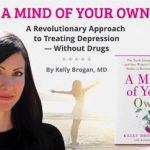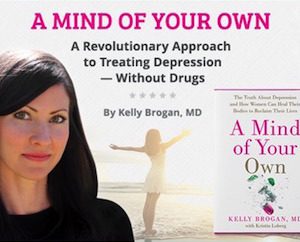Educating and Empowering You to Heal, Thrive, and Live a Happy, Healthy Lifestyle
 3 Calming Practices for Anxiety by Kelly Brogan, MD
3 Calming Practices for Anxiety by Kelly Brogan, MD
“Anxiety is a signal of imbalance; a need for change, inner focus & growth.” —Kelly Brogan, MD
One of my long term goals is to set up holistic rehab facilities for patients withdrawing from psychiatric medications. What I have witnessed in my practice around benzodiazepine (“anti-anxiety”) medication dependence has been sobering. Finally, there is an emerging acknowledgement that antidepressants are habit forming, but medications like Xanax and Valium have been known to be addictive for many decades.
Nonetheless, unsuspecting patients are written prescriptions for months to years on end. There are entire websites devoted to supporting patients in their journey off these medications which can incur both short and long-term side effects.
One of the most powerful solutions for anxiety, particularly when it is bodily in nature (racing heart, sweating, muscle tension, stomach discomfort, headaches) is blood sugar stabilization.
Reactive hypoglycemia masquerades as anxiety and panic attacks, particularly in women.
In the absence of a physiologic driver, anxiety can be important. It is a signal of imbalance. A signal of a need for inner focus. A signal of a need for growth and for change. When we can react less and meet that anxiety with a watching eye, shifts can happen.
3 Calming Practices for Anxiety
. . . that are Better Than Taking a Pill
Here are three relatively quick fixes that serve to promote that subtle resilience (to take the edge off) so that this symptom can be better examined.
1. Left nostril breathing. The Kundalini yoga method of left nostril breathing activates the nerve ending in the left nostril, which relates to calmness and relaxation. Left nostril breathing is associated with the moon energy, which is changeable, the feminine, yin energy, and coolness. Breathing through the left nostril for five minutes can help calm you and lower your blood pressure.
To practice this form of pranayama (the art and science of yogic breathing techniques), sit comfortably in a cross-legged position. Close your right nostril with your right thumb, with your other fingers outstretched. Your left hand is in Gyan Mudra (tip of thumb and index finger touching) on your left knee. Close your eyes and send your attention inward, to your third eye. Begin to breathe long and deep, only through your left nostril for 3-5 minutes.
2. Drink grass-fed gelatin. Because our diets are typically heavy in methionine-rich muscle meats, we miss out on the abundant glycine in bones and connective tissues. Studied in randomized trials for sleep, and active at the NMDA receptor, glycine is an amino acid with calming properties.
Use grass-fed gelatin in warm liquids or whole body hydrolyzed collagen in cold or add to a green smoothie. Start with one tablespoon and work up to two. It’s flavorless!
3. Soak in an Epsom salt bath. Half of my Manhattan patients don’t even have a bath tub or they use it as a guest bed. Structuring an Epsom salt bath into the end of a stressful day is an act of self-care, and can also double as a mineral cure for anxiety. Epsom salt (magnesium sulfate) is readily absorbed through the skin, getting to work on optimizing detoxification and cellular function. Often called the “relaxation mineral,” magnesium is calming to the sympathetic nervous system. Add 3-4 cups of Epsom salts to filtered bath water and soak for at least 20 minutes.
Supporting your body and mind through dis-ease offers you the opportunity to take a mindful look at symptoms and states, so that necessary changes can be made and that which is not serving us can be willfully released. Don’t fight yourself, because the body and mind fight back. There’s a gentler way.

This article was written by Kelly Brogan M.D. Dr. Brogan is the author of A Mind of Your Own: The Truth About Depression and How Women Can Heal Their Bodies to Reclaim Their Lives. Dr. Brogan studied cognitive neuroscience at MIT before receiving her MD from Weill Cornell Medical College. Board certified in psychiatry, psychosomatic medicine, and integrative holistic medicine, she is one of the only doctors in the nation with these qualifications. Visit Dr. Brogan’s website.
Related Articles
- Natural Remedies for Depression and Mood Disorders
- Are You Deficient in this Magical Mineral? Health Benefits of Magnesium
- The Importance of Strengthening Your Vagal Tone
- Video: Free At-home Food Sensitivity Test

